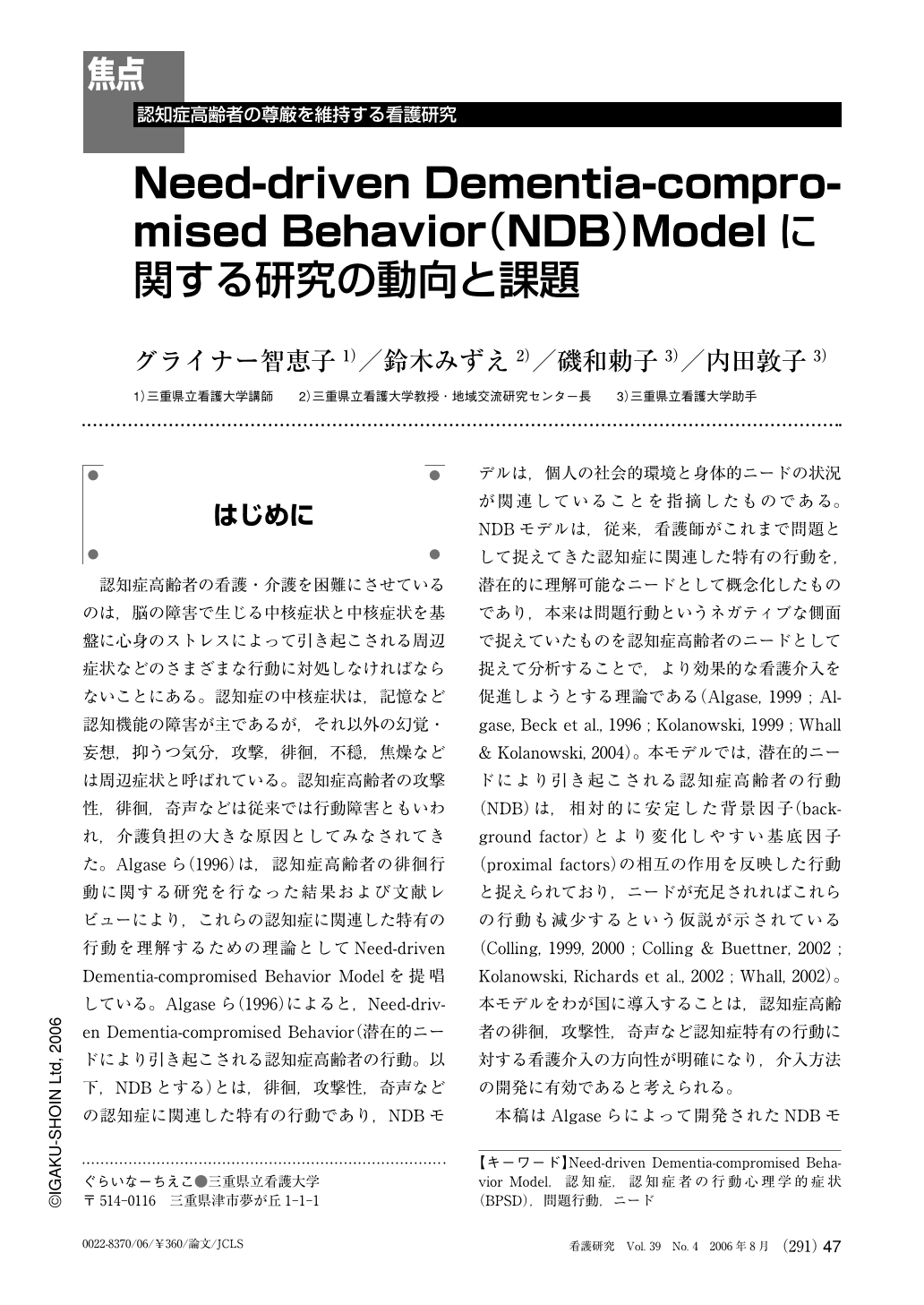Japanese
English
- 有料閲覧
- Abstract 文献概要
- 1ページ目 Look Inside
- 参考文献 Reference
はじめに
認知症高齢者の看護・介護を困難にさせているのは,脳の障害で生じる中核症状と中核症状を基盤に心身のストレスによって引き起こされる周辺症状などのさまざまな行動に対処しなければならないことにある。認知症の中核症状は,記憶など認知機能の障害が主であるが,それ以外の幻覚・妄想,抑うつ気分,攻撃,徘徊,不穏,焦燥などは周辺症状と呼ばれている。認知症高齢者の攻撃性,徘徊,奇声などは従来では行動障害ともいわれ,介護負担の大きな原因としてみなされてきた。Algaseら(1996)は,認知症高齢者の徘徊行動に関する研究を行なった結果および文献レビューにより,これらの認知症に関連した特有の行動を理解するための理論としてNeed-driven Dementia-compromised Behavior Modelを提唱している。Algaseら(1996)によると,Need-driven Dementia-compromised Behavior(潜在的ニードにより引き起こされる認知症高齢者の行動。以下,NDBとする)とは,徘徊,攻撃性,奇声などの認知症に関連した特有の行動であり,NDBモデルは,個人の社会的環境と身体的ニードの状況が関連していることを指摘したものである。NDBモデルは,従来,看護師がこれまで問題として捉えてきた認知症に関連した特有の行動を,潜在的に理解可能なニードとして概念化したものであり,本来は問題行動というネガティブな側面で捉えていたものを認知症高齢者のニードとして捉えて分析することで,より効果的な看護介入を促進しようとする理論である(Algase, 1999 ; Algase, Beck et al., 1996 ; Kolanowski, 1999 ; Whall & Kolanowski, 2004)。本モデルでは,潜在的ニードにより引き起こされる認知症高齢者の行動(NDB)は,相対的に安定した背景因子(background factor)とより変化しやすい基底因子(proximal factors)の相互の作用を反映した行動と捉えられており,ニードが充足されればこれらの行動も減少するという仮説が示されている(Colling, 1999, 2000 ; Colling & Buettner, 2002 ; Kolanowski, Richards et al., 2002 ; Whall, 2002)。本モデルをわが国に導入することは,認知症高齢者の徘徊,攻撃性,奇声など認知症特有の行動に対する看護介入の方向性が明確になり,介入方法の開発に有効であると考えられる。
本稿はAlgaseらによって開発されたNDBモデルを紹介し,本モデルを活用した研究論文の動向と課題について考察する。
Problematic behaviors, behavior disorders, or behavioral and psychological symptoms of dementia (BPSD), such as aggression or wandering, are perceived as behavior that is unpleasant and threatening to those in its vicinity. The Need-driven Dementia-compromised Behavior (NDB) Model has conceptualized these behaviors found in people with dementia as understandable potential needs; the model was developed with the view that dementia specific behaviors, such as wandering, will be reduced if these needs are satisfied. In this model, NDBs reflect an interaction of background factors, relatively stable personal characteristics, and proximal factors, more flexible environmental factors. This article, together with introducing how the NDB model developed by Dr. Algase al et. came about, summarizes research trends in this area. Furthermore, it explains the recently published Consequences of Need-Driven Dementia-compromised Behavior (C-NDB) theory.

Copyright © 2006, Igaku-Shoin Ltd. All rights reserved.


